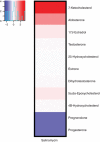Salinomycin inhibits prostate cancer growth and migration via induction of oxidative stress
- PMID: 22215106
- PMCID: PMC3251868
- DOI: 10.1038/bjc.2011.530
Salinomycin inhibits prostate cancer growth and migration via induction of oxidative stress
Abstract
Background: We have shown that a sodium ionophore monensin inhibits prostate cancer cell growth. A structurally related compound to monensin, salinomycin, was recently identified as a putative cancer stem cell inhibitor.
Methods: The growth inhibitory potential of salinomycin was studied in a panel of prostate cells. To get insights into the mechanism of action, a variety of assays such as gene expression and steroid profiling were performed in salinomycin-exposed prostate cancer cells.
Results: Salinomycin inhibited the growth of prostate cancer cells, but did not affect non-malignant prostate epithelial cells. Salinomycin impacted on prostate cancer stem cell functions as evidenced by reduced aldehyde dehydrogenase activity and the fraction of CD44(+) cells. Moreover, salinomycin reduced the expression of MYC, AR and ERG, induced oxidative stress as well as inhibited nuclear factor-κB activity and cell migration. Furthermore, profiling steroid metabolites revealed increased levels of oxidative stress-inducing steroids 7-ketocholesterol and aldosterone and decreased levels of antioxidative steroids progesterone and pregnenolone in salinomycin-exposed prostate cancer cells.
Conclusion: Our results indicate that salinomycin inhibits prostate cancer cell growth and migration by reducing the expression of key prostate cancer oncogenes, inducing oxidative stress, decreasing the antioxidative capacity and cancer stem cell fraction.
Figures







References
-
- Auten RL, Davis JM (2009) Oxygen toxicity and reactive oxygen species: the devil is in the details. Pediatr Res 66: 121–127 - PubMed
-
- Benassi B, Fanciulli M, Fiorentino F, Porrello A, Chiorino G, Loda M, Zupi G, Biroccio A (2006) c-Myc phosphorylation is required for cellular response to oxidative stress. Mol Cell 21: 509–519 - PubMed
-
- Birnie R, Bryce SD, Roome C, Dussupt V, Droop A, Lang SH, Berry PA, Hyde CF, Lewis JL, Stower MJ, Maitland NJ, Collins AT (2008) Gene expression profiling of human prostate cancer stem cells reveals a pro-inflammatory phenotype and the importance of extracellular matrix interactions. Genome Biol 9: R83. - PMC - PubMed
-
- Blum R, Gupta R, Burger PE, Ontiveros CS, Salm SN, Xiong X, Kamb A, Wesche H, Marshall L, Cutler G, Wang X, Zavadil J, Moscatelli D, Wilson EL (2009) Molecular signatures of prostate stem cells reveal novel signaling pathways and provide insights into prostate cancer. PLoS One 4: e5722. - PMC - PubMed
MeSH terms
Substances
LinkOut - more resources
Full Text Sources
Other Literature Sources
Medical
Research Materials
Miscellaneous

